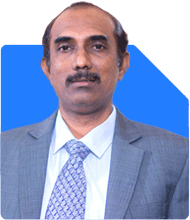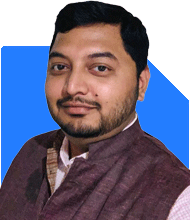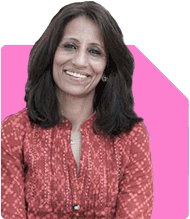Ramalingam Kalirajan |10878 Answers |Ask -Follow
Mutual Funds, Financial Planning Expert - Answered on Jul 21, 2025
He has an MBA in finance from the University of Madras and is a certified financial planner.
He is the director and chief financial planner at Holistic Investment, a Chennai-based firm that offers financial planning and wealth management advice.... more

HI, I am a retired Govt. Employee and have 2 housing properties. Non of them are rented. I will be getting 70L as PF settlement + leave encashment and 40k per month as a pension. my need is to get total 70k per month to fulfill my monthly expenses. Please suggest me good investment tips.
? Understanding Your Financial Needs
– You already receive Rs 40,000 monthly as pension.
– You need an extra Rs 30,000 monthly to meet your needs.
– That is Rs 3.6 lakh per year.
– Your Rs 70 lakh corpus must be invested to generate this income.
– You also need to beat inflation and preserve capital.
? First Priority: Emergency Fund
– Keep Rs 4 to 5 lakh in a savings account or sweep-in FD.
– This will take care of any urgent expenses.
– Medical emergencies or home repairs can be met from here.
– This is not for investment or monthly withdrawal.
? Second Priority: Cash Flow Planning
– From your balance Rs 65 lakh, we will create regular income.
– You need Rs 30,000 per month income from this.
– You can aim for 5% to 6% post-tax returns yearly.
– That will be around Rs 3.25 to 3.9 lakh per year.
– The remaining corpus can also grow slowly over time.
? Smart Allocation for Stability and Growth
– Use a bucket strategy with three parts:
Short term (0–3 years)
Medium term (3–7 years)
Long term (7+ years)
– This approach balances safety and growth.
– It avoids selling growth assets in a down market.
? Bucket 1: Short-Term Income (Rs 10–12 lakh)
– Keep this in ultra-short debt mutual funds or bank FDs.
– Use it for systematic withdrawal plans (SWP) monthly.
– This will meet your income need for the next 3 years.
– Debt mutual funds here must be low duration.
? Bucket 2: Medium-Term Stability (Rs 20–25 lakh)
– Invest this in conservative hybrid mutual funds.
– These are actively managed and suited for 3–7 years.
– They have a mix of debt and equity.
– Equity gives growth; debt gives stability.
– They are less volatile than pure equity funds.
– You can shift this to Bucket 1 after 3 years.
? Bucket 3: Long-Term Growth (Rs 28–30 lakh)
– Invest in balanced advantage or multi-asset mutual funds.
– These are actively managed, not passive like index funds.
– They adjust equity-debt based on market conditions.
– They aim to grow your money safely over 7+ years.
– This ensures you don’t run out of funds in old age.
? Why Avoid Index Funds
– Index funds are not ideal for retirement income.
– They do not adjust in bad markets.
– Passive funds fall as much as the market.
– You need actively managed funds to reduce risk.
– A good fund manager manages volatility better.
? The Taxation Angle
– Equity mutual fund LTCG above Rs 1.25 lakh is taxed at 12.5%.
– STCG in equity funds is taxed at 20%.
– Debt mutual fund gains are taxed as per your slab.
– Plan your SWP from equity funds after 1 year to lower tax.
– Choose funds with SWP option under growth plan.
– SWP from growth funds gives better tax efficiency.
? The Role of Regular Plans via MFD with CFP
– Avoid direct funds unless you track markets actively.
– Regular funds through a certified MFD guided by a CFP is safer.
– MFD-CFP helps you choose and track best-performing funds.
– They assist in portfolio rebalancing and tax harvesting.
– They protect you from making panic decisions in market falls.
? Use SWP – Not Dividend Options
– Don’t opt for mutual fund dividend plans.
– SWP is more reliable and tax-efficient.
– You can fix Rs 25,000 to Rs 30,000 per month from SWP.
– Withdraw from short-term and hybrid funds first.
– Let long-term funds grow for later years.
? Medical and Health Safety
– Do you have personal health insurance after retirement?
– If not, consider taking a senior citizen health policy.
– Government pensioners can also access CGHS or ECHS.
– You can also maintain a medical buffer of Rs 5 lakh.
? Optional: Rental Income Planning
– You have two properties but none are rented.
– Consider renting at least one house.
– Even Rs 10,000–15,000 rent will reduce burden on investments.
– It also provides inflation-adjusted passive income.
– Keep one property for future sale if needed.
? Avoid Investment Mistakes
– Don’t put large money in corporate FDs or unknown NBFCs.
– Don’t get attracted by ULIPs, traditional LIC plans now.
– Don’t mix insurance with investment.
– Don’t lend money to relatives unless you can afford to lose it.
– Don’t over-expose to equity due to fear of inflation.
? Review Investments Yearly
– Retirement is a 20–30 year journey, not one-time planning.
– Review your fund performance and withdrawals each year.
– Rebalance between buckets every 2–3 years.
– Shift money from long-term funds to short-term as needed.
– This keeps your income stable even if market fluctuates.
? Think About Legacy Planning
– Make a Will to pass on your properties and funds.
– Nominate your family in all mutual funds and bank accounts.
– Keep a record of all investments in one place.
– Inform spouse or family member about financial details.
– This avoids confusion during health issues or emergencies.
? Finally
– Your Rs 70 lakh can support Rs 30,000 monthly with proper planning.
– A mix of debt and equity mutual funds is best for this.
– Use the bucket method to plan cash flows for 30 years.
– Avoid index funds, direct funds, and annuity traps.
– Work with a Certified Financial Planner and trusted MFD for execution.
– Revisit your plan every year and adjust slowly.
– Renting out one property adds more safety to this plan.
– Stay invested in a disciplined, tax-smart way.
Best Regards,
K. Ramalingam, MBA, CFP,
Chief Financial Planner,
www.holisticinvestment.in
https://www.youtube.com/@HolisticInvestment
You may like to see similar questions and answers below
Ramalingam Kalirajan |10878 Answers |Ask -Follow
Mutual Funds, Financial Planning Expert - Answered on Jul 12, 2024
Ramalingam Kalirajan |10878 Answers |Ask -Follow
Mutual Funds, Financial Planning Expert - Answered on Jul 13, 2024
Ramalingam Kalirajan |10878 Answers |Ask -Follow
Mutual Funds, Financial Planning Expert - Answered on Jun 20, 2025
Samraat Jadhav |2503 Answers |Ask -Follow
Stock Market Expert - Answered on Dec 10, 2025
Radheshyam Zanwar |6741 Answers |Ask -Follow
MHT-CET, IIT-JEE, NEET-UG Expert - Answered on Dec 10, 2025
Ramalingam Kalirajan |10878 Answers |Ask -Follow
Mutual Funds, Financial Planning Expert - Answered on Dec 10, 2025
Ramalingam Kalirajan |10878 Answers |Ask -Follow
Mutual Funds, Financial Planning Expert - Answered on Dec 10, 2025
Samraat Jadhav |2503 Answers |Ask -Follow
Stock Market Expert - Answered on Dec 10, 2025
Samraat Jadhav |2503 Answers |Ask -Follow
Stock Market Expert - Answered on Dec 10, 2025
Samraat Jadhav |2503 Answers |Ask -Follow
Stock Market Expert - Answered on Dec 10, 2025
Shalini Singh |180 Answers |Ask -Follow
Dating Coach - Answered on Dec 10, 2025
Radheshyam Zanwar |6741 Answers |Ask -Follow
MHT-CET, IIT-JEE, NEET-UG Expert - Answered on Dec 09, 2025
Naveenn Kummar |235 Answers |Ask -Follow
Financial Planner, MF, Insurance Expert - Answered on Dec 09, 2025











.jpg)













